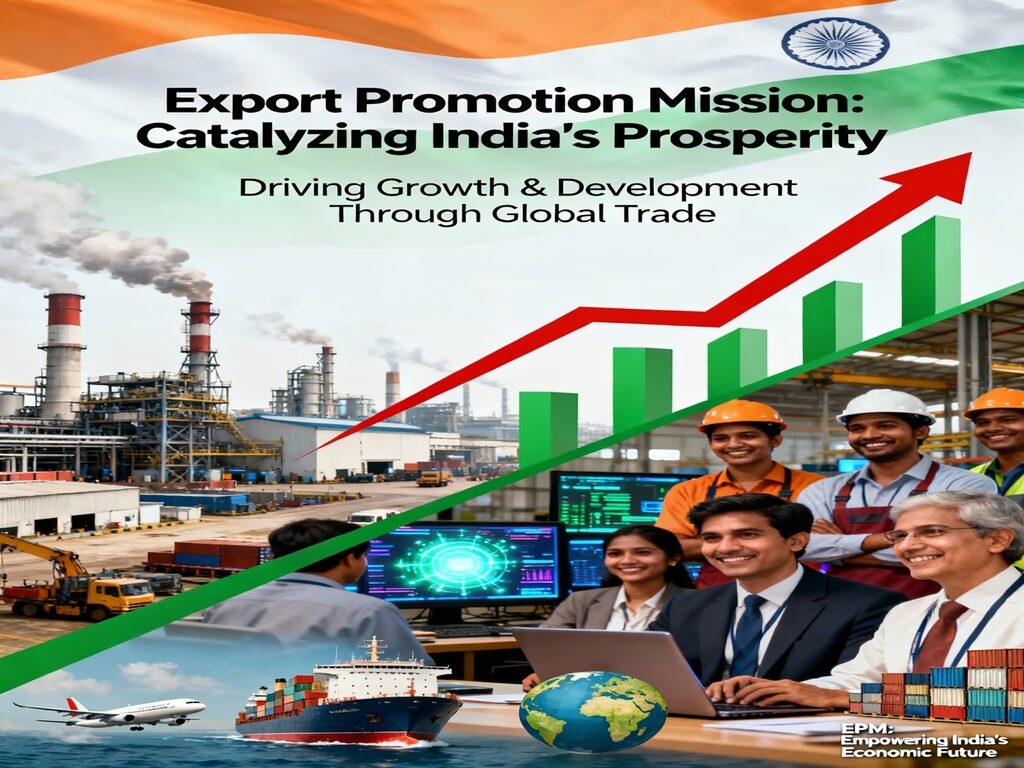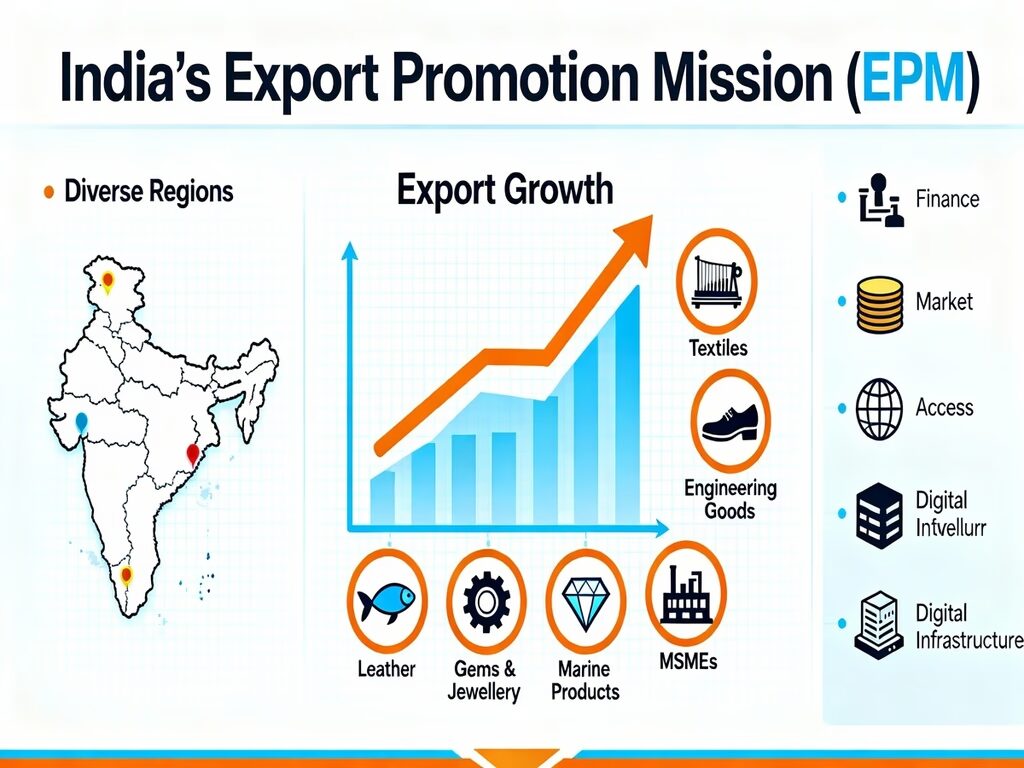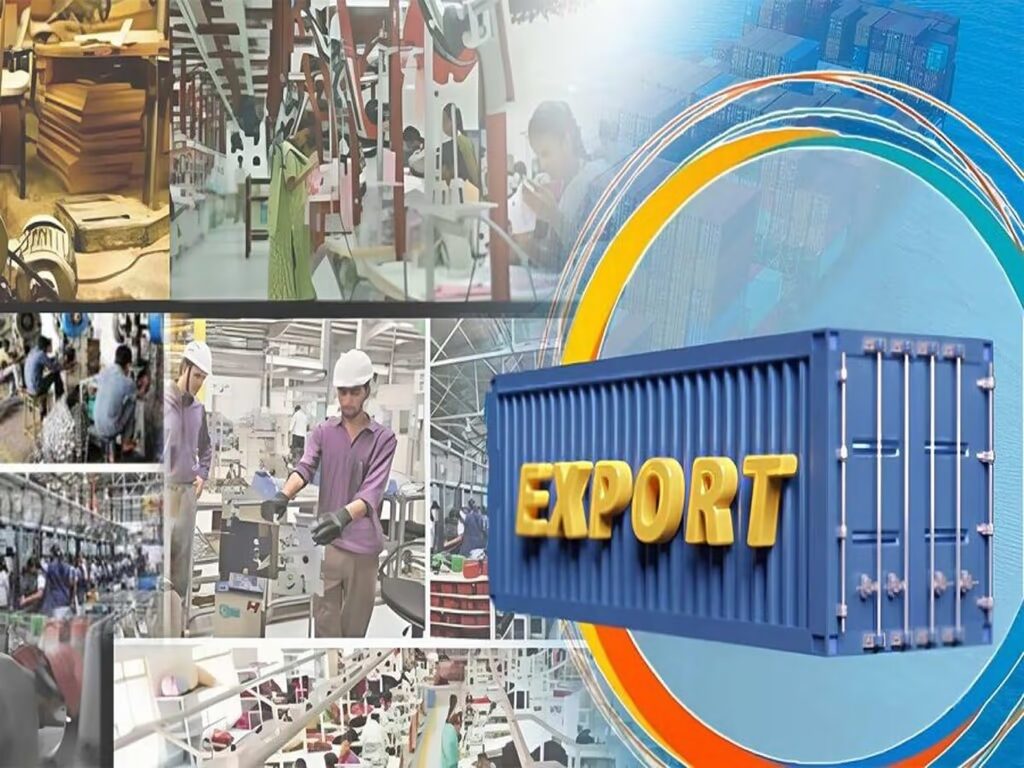
On 12 November 2025, the Union Cabinet approves the proposal of the Export Promotion Mission (EPM) highlighted in the Union Budget of 2025-2026. This remarkable initiative will boost domestic exports and help MSMEs expand their businesses. It will also help the producers to introduce their products at an international level. The substantial investment of ₹25,060 reflects India’s commitment to showcasing its presence on the global stage and strengthening its export ecosystem. The EPM focuses on supporting exporters, businesses and rural enterprises through improved market access, technology advancements, and policy reforms. This ambitious step is expected to drive export-led economic growth and position India as a stronger player in the global trade landscape. Read further to get a thorough overview of the Export Promotion Mission, how it will affect the Indian economy and the challenges faced by it.
ALSO READ- National Urban Conclave 2025: Shaping Inclusive and Resilient Indian Cities
Important Updates-
- The EPM will strengthen India’s export ecosystem, especially by supporting MSMEs and first-time exporters and bringing labour-intensive sectors like textiles, leather, gems and jewellery, engineering goods, and marine products to the forefront.
- It consolidates multiple fragmented schemes, including the Interest Equalisation Scheme and Market Access Initiative, into a single, digitally driven, outcome-based framework to address challenges such as expensive trade finance, high compliance costs, fragmented market access, and logistical constraints.
- EPM works through two sub-schemes: Niryat Protsahan, which enhances access to affordable trade finance, and Niryat Disha, which offers non-financial support like export quality, certification, branding, and logistics.
- The mission will be able to ensure continuity of export orders, generate employment, enhance visibility in the markets, and encourage diversification into new geographies in line with India’s vision for a strong global export presence.
Overview of Export Promotion Mission-
The EPM, approved by the Union Cabinet in November 2025, is an integrated scheme announced in the Union Budget 2025-26, which aims at enhancing India’s export competitiveness while ensuring broad-based and sustainable export growth from fiscal years 2025-26 to 2030-31.
- To be implemented by the Directorate General of Foreign Trade (DGFT) under the joint leadership of the Ministries of Commerce and Industry, MSMEs, and Finance, the mission will address critical challenges of Indian exporters, especially MSMEs and labour-intensive sectors, to increase their access to affordable trade finance.
- It will also focus on market visibility and compliance support, coupled with targeted expansion into non-traditional districts and sectors.
- The EPM seeks to bring several export support schemes under a single digital, flexible framework to create an adaptable ecosystem.
- Through financial assistance, market development, export quality compliance, and capacity building, the mission will help reinforce India’s global export position and foster employment, while protecting its exporters against global trade uncertainties such as tariff hikes.
Objectives of EPM 2025:
- The EPM’s key objectives are to boost India’s exports by resolving critical challenges that exporters face, especially Micro, Small and Medium Enterprises (MSMEs).
- It will also facilitate access to affordable export credit and liquidity on an equitable basis under mechanisms like interest equalisation, alternative trade finance instruments, and credit for e-commerce exporters.
- Assisting exporters in overcoming non-tariff barriers imposed in many of the new export markets is another major objective.
- Complex regulations, standards, and compliance requirements in these countries have been seriously impeding market access.
- Some of the other critical objectives of EPM include capacity building, quality improvement, branding, and global market development under the Viksit Bharat by 2047.

Key Components of EPM-
EPM functions through two major sub-schemes, namely Niryat Protsahan and Niryat Disha, both structured to extend holistic assistance to the exporters of India:
- Niryat Protsahan endeavours to alleviate the exporters’ fiscal burden by facilitating access to affordable trade finance. It offers interest equalisation subsidies on pre- and post-shipment credit, export factoring, collateral-free credit guarantees, and specific credit cards for e-commerce exporters. This sub-scheme facilitates bridging liquidity gaps, thereby encouraging alternate financing instruments and supporting diversification into newer markets, especially benefiting MSMEs and first-time exporters.
- Niryat Disha provides non-financial support in market preparation and increasing global competitiveness. This is inclusive of assistance for compliance towards export quality, certification, and audits required to meet relevant standards abroad. It also promotes market access in the form of exposure through trade fairs, buyer-seller meets, and product demonstrations. Other components are export warehousing, reimbursement of logistics cost, capacity building, branding, packaging support, and trade intelligence. Put together, these schemes spell a digitised comprehensive architecture for strengthening India’s export ecosystem with the aim of expanding the country’s footprint in global trade.
ALSO READ- ISRO Successfully Launches GSAT-7R (CMS-03) Aboard LVM3
The Target Sectors of Export Promotion Mission-
The central government has introduced EPM in the budget to benefit those areas that require financial strength and exposure to the international market:
- MSME Focus: The mission focuses on empowering MSMEs (Micro, Small, and Medium Enterprises) in India’s export ecosystem.
- Support to Key Sectors: It benefits the labour-intensive sectors like textiles, leather, engineering goods, gems and jewellery, and marine products.
- Employment Generation: These industries have been emphasised to generate large-scale employment opportunities in the country.
- Regional Diversification: The initiative promotes exports from various states and districts to balance regional economic growth.
- Competitiveness Enhancement: It seeks to enhance productivity, quality standards, and global competitiveness for small and medium businesses.
- Infrastructure and Market Access: The mission supports exporters by promoting better trade infrastructure and increasing access to markets abroad.
- Inclusive Export Growth: By empowering various sectors and different regions, the mission promotes inclusive, broad-based, and sustainable export development for long-term national growth.

The Future of EPM as Economic Accelerator-
The future of the Export Promotion Mission, an Economic Accelerator, is bright for India’s economy, with a comprehensive and focused approach that entails the following:
- Improved Access to Credit: The mission will provide easy and affordable export credit, especially to MSMEs, by reducing the burden of collateral and financial requirements.
- Sector-specific support: It includes the fixation of export targets for key sectors such as textiles, marine products, gems & jewellery, engineering goods, and leather would enhance their international competitiveness.
- Inclusive Growth: Promoting exports from diverse regions and non-traditional districts contributes to balanced regional economic development.
- Market Diversification: The mission will enable exporters to overcome non-tariff barriers and reach the growing global markets with improved market access support.
- Export Ecosystem Strengthening: The integration of multiple export schemes under one digitally driven platform ensures smooth processes and quicker support.
- Employment Generation: By promoting labour-intensive sectors, employment generation in manufacturing, logistics, and allied services will be boosted all over the country.
- Quality and Compliance: Assists exporters in attaining international standards, certification, and branding for better recognition in the international market.
- Sustainable Export Growth: Having an outlay of Rs 25,000 crore till 2030-31, the mission will have broad-based sustainable export growth, driving India’s economic resilience and global trade presence.
Conclusion-
The EPM is a transformational initiative towards developing India’s export ecosystem, supported by an investment of ₹25,060 crore. It merges various fragmented schemes into one single, digitally enabled framework that directly addresses the key structural challenges faced by exporters, especially MSMEs. The mission will make Indian exporters globally competitive through mechanisms such as enhanced access to affordable export credit, facilitating cross-border factoring, and assistance on compliance and market access. Inclusive growth will be fostered by focusing on the high-potential and labour-intensive sectors and increasing exports from non-traditional regions. Overall, the Export Promotion Mission is poised to accelerate broad-based and sustainable export growth, protect jobs, and reinforce India’s position in global trade, aligning with the government’s vision of a Viksit Bharat-developed India by 2047.
